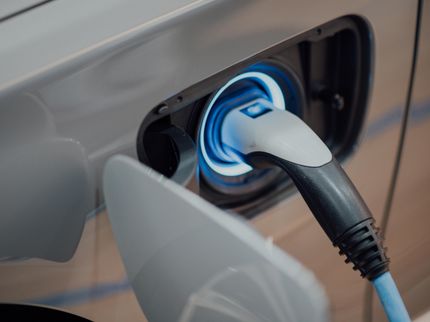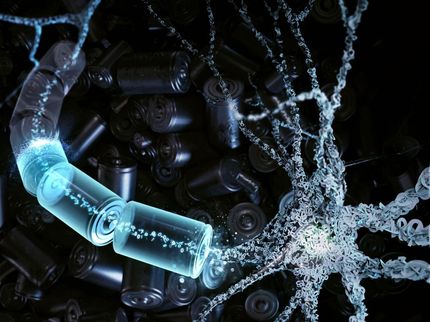Battery breakthrough gives boost to electric flight and long-range electric cars
Researchers have designed new solid electrolytes that light the path to wider electrification of transportation
In the pursuit of a rechargeable battery that can power electric vehicles (EVs) for hundreds of miles on a single charge, scientists have endeavored to replace the graphite anodes currently used in EV batteries with lithium metal anodes.

Researchers at Berkeley Lab and Carnegie Mellon University have designed new solid electrolytes that light the path to wider electrification of transportation.
Courtesy of Jinsoo Kim
But while lithium metal extends an EV's driving range by 30-50%, it also shortens the battery's useful life due to lithium dendrites, tiny treelike defects that form on the lithium anode over the course of many charge and discharge cycles. What's worse, dendrites short-circuit the cells in the battery if they make contact with the cathode.
For decades, researchers assumed that hard, solid electrolytes, such as those made from ceramics, would work best to prevent dendrites from working their way through the cell. But the problem with that approach, many found, is that it didn't stop dendrites from forming or "nucleating" in the first place, like tiny cracks in a car windshield that eventually spread.
Now, researchers at the Department of Energy's Lawrence Berkeley National Laboratory (Berkeley Lab), in collaboration with Carnegie Mellon University, have reported in the journal Nature Materials a new class of soft, solid electrolytes - made from both polymers and ceramics - that suppress dendrites in that early nucleation stage, before they can propagate and cause the battery to fail.
The technology is an example of Berkeley Lab's multidisciplinary collaborations across its user facilities to develop new ideas to assemble, characterize, and develop materials and devices for solid state batteries.
Solid-state energy storage technologies such as solid-state lithium metal batteries, which use a solid electrode and a solid electrolyte, can provide high energy density combined with excellent safety, but the technology must overcome diverse materials and processing challenges.
"Our dendrite-suppressing technology has exciting implications for the battery industry," said co-author Brett Helms, a staff scientist in Berkeley Lab's Molecular Foundry. "With it, battery manufacturers can produce safer lithium metal batteries with both high energy density and a long cycle life."
Helms added that lithium metal batteries manufactured with the new electrolyte could also be used to power electric aircraft.
A soft approach to dendrite suppression
Key to the design of these new soft, solid-electrolytes was the use of soft polymers of intrinsic microporosity, or PIMs, whose pores were filled with nanosized ceramic particles. Because the electrolyte remains a flexible, soft, solid material, battery manufacturers will be able to manufacture rolls of lithium foils with the electrolyte as a laminate between the anode and the battery separator. These lithium-electrode sub-assemblies, or LESAs, are attractive drop-in replacements for the conventional graphite anode, allowing battery manufacturers to use their existing assembly lines, Helms said.
To demonstrate the dendrite-suppressing features of the new PIM composite electrolyte, the Helms team used X-rays at Berkeley Lab's Advanced Light Source to create 3D images of the interface between lithium metal and the electrolyte, and to visualize lithium plating and stripping for up to 16 hours at high current. Continuously smooth growth of lithium was observed when the new PIM composite electrolyte was present, while in its absence the interface showed telltale signs of the early stages of dendritic growth.
These and other data confirmed predictions from a new physical model for electrodeposition of lithium metal, which takes into account both chemical and mechanical characteristics of the solid electrolytes.
"In 2017, when the conventional wisdom was that you need a hard electrolyte, we proposed that a new dendrite suppression mechanism is possible with a soft solid electrolyte," said co-author Venkat Viswanathan, an associate professor of mechanical engineering and faculty fellow at Scott Institute for Energy Innovation at Carnegie Mellon University who led the theoretical studies for the work. "It is amazing to find a material realization of this approach with PIM composites."
An awardee under the Advanced Research Projects Agency-Energy's (ARPA-E) IONICS program, 24M Technologies, has integrated these materials into larger format batteries for both EVs and eVTOL (electric vertical takeoff and landing) aircraft.
"While there are unique power requirements for EVs and eVTOLs, the PIM composite solid electrolyte technology appears to be versatile and enabling at high power," said Helms.
Original publication
Other news from the department science
Most read news
More news from our other portals
See the theme worlds for related content
Topic World Battery Technology
The topic world Battery Technology combines relevant knowledge in a unique way. Here you will find everything about suppliers and their products, webinars, white papers, catalogs and brochures.

Topic World Battery Technology
The topic world Battery Technology combines relevant knowledge in a unique way. Here you will find everything about suppliers and their products, webinars, white papers, catalogs and brochures.





























































